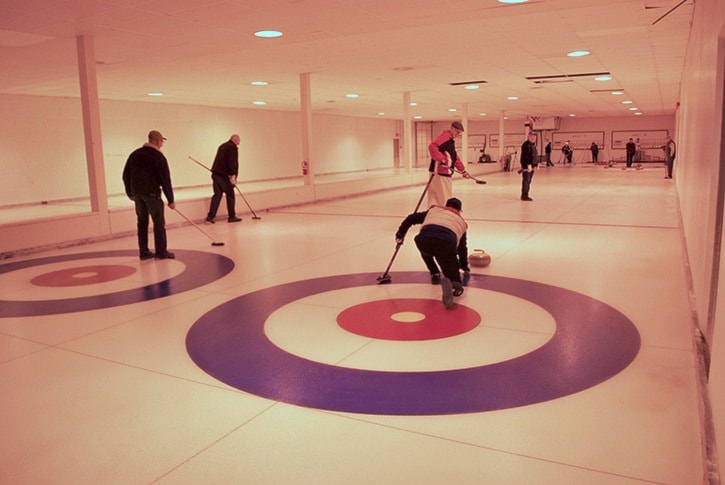Where can you find singing rocks? In the basement of the Nakusp Arena. The ice is in and the rocks are waiting for you in the curling rink.
On a wet Tuesday afternoon I popped in to join drop-in curling. Although I was definitely the most junior (and most inexperienced) player, I was welcomed and told to get a move on and throw a rock.
If you’re familiar with the sport you already know that throwing a rock isn’t the same as lobbing it into the air. And good luck with that anyway, because curling rocks are heavy – really heavy: they weigh between 17 and 20 kilos. No, chucking rocks in curling is a trick of balance, force, and spin.
I quickly put on a small rubber shoe cover, a slider, which is a lot like rubber shoe protectors of old that shielded dress shoes from rain and mud (I don’t see a lot of them any more; I used to have a rubber pair for heels which were hilariously cartoony when worn without a shoe underneath). The slider allows your foot to slide on the ice as you get low and push the rock toward its target.
A word about the ice: it’s not flat, it’s kind of pebbly. I’d imagined the ice was like the rink upstairs in the arena, but not so. On the curling sheet (the play area), the ice is groomed to be a little bumpy, and the finished surface texture feels like hail has fallen, melted slightly and then refrozen. For those of you born with rocks in your blood, this is old news, I’m sure, but I was delighted.
Even more delightful is the sound the rocks make as they slide toward their target. They sing! As they curl (you put a slight spin on the rock when you throw it) over the orange-peel surface of the ice, the rock makes a beautiful meditative sound as it scrapes its way to the blue and red target.
But unless you’re throwing the stone, and throwing it well, you’ve got more important things to do than just listen to the rock sing. You’ve got housekeeping to do!
Earl Frerichs, our skip, hollered to get sweeping, scrubbing the path in front of the rock and smoothing the way so it will reach its destination. If the throw is too heavy, it will shoot too far and miss its mark. If it’s too light, it just won’t get to where it needs to go, but sweeping can help the rock along (if I were writing a hip hop song about curling, it would have to have the line “I’m throwing the rocks like little Miss Goldilocks: just right”).
The brooms are more like some kind of enlarged dish-scrubbing utensil to polish the pebbly ice in front of the moving rock. Adept curlers glide on their slider shoe just in front of the icy missile and scrub; I race in tiny steps to keep up and scrub as fast as I can.
Curling, when you know what you’re doing and are attempting more than just standing upright on the ice while figuring out how to throw or sweep, is a game of strategy, tactics and skill. I could see this, even though I hardly knew where to stand or what to do.
Points are awarded to the team with the rock nearest to the button, or centre point of the target, for not only that rock but any of their rocks that are closer to it than the other team’s nearest rock. Got that?
So what you want to do, ideally, is get as near to the centre as possible and not let any of the opposing team’s rocks get close. Once you know what you’re doing it’s more likely. As it was, one of my throws ended up in a good defensive position, luckily.
If you want to hear the stones sing, drop in to the curling rink at 1 p.m. on Tuesdays, and you’ll be on the ice learning how to throw stones in no time at all. For more information on the drop in or the Men’s League (women are also welcome, but they have to wear a moustache in Movember, teased Charlie Granewall), you can call Brian Weatherhead at 250-265-3133.
